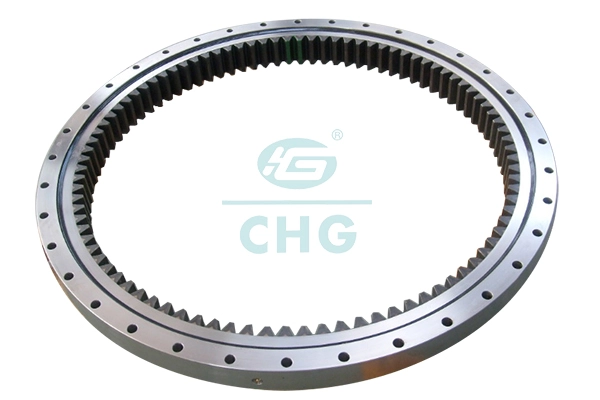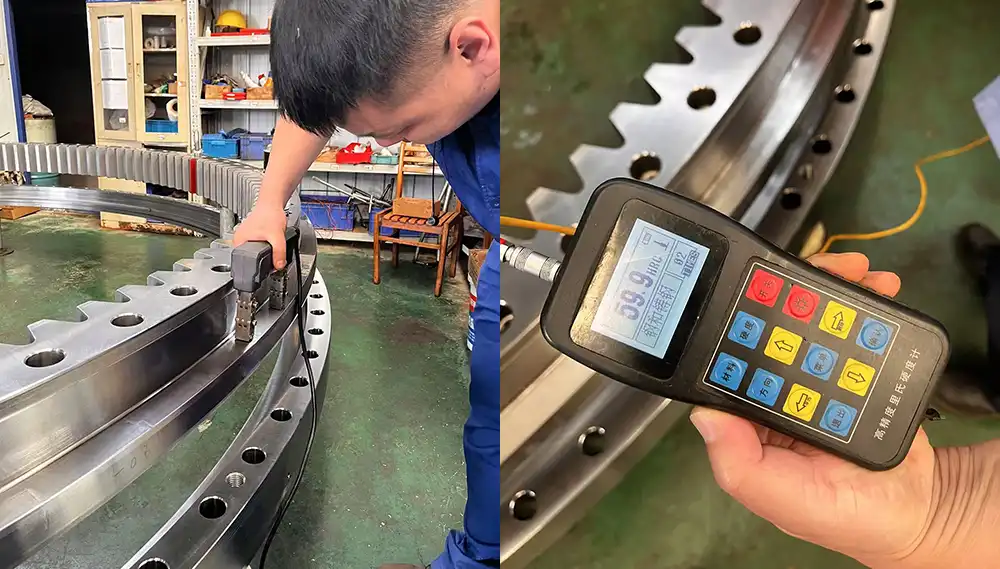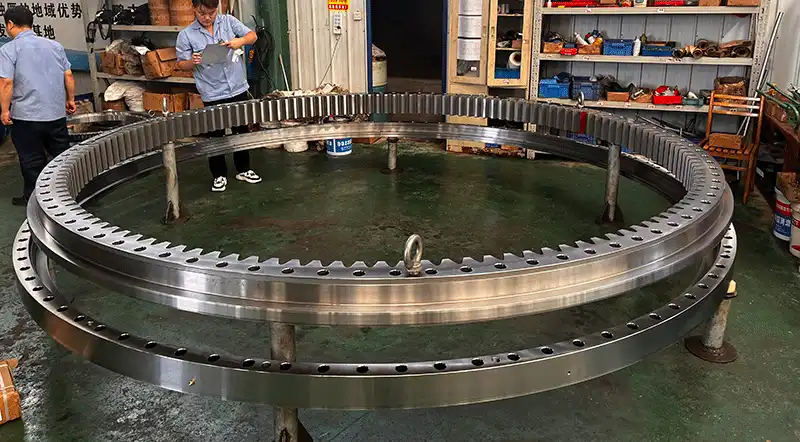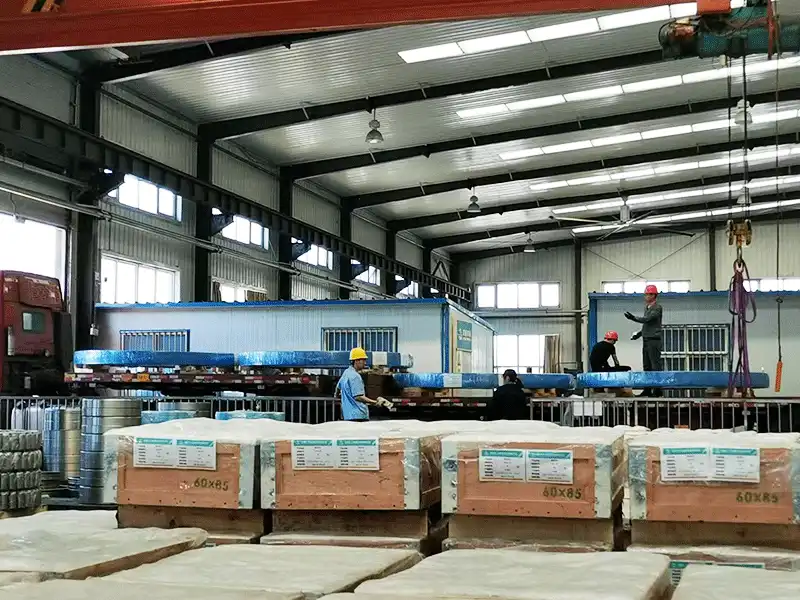Can a Single Row Ball Slewing Bearing be Used in High-Torque Applications?
Single row ball slewing bearings represent a critical component in modern mechanical engineering, serving as pivotal elements in numerous high-performance industrial applications. The central question of whether these sophisticated bearings can effectively manage high-torque scenarios is one that engineers, designers, and industry professionals continually explore. This comprehensive analysis delves deep into the capabilities, structural characteristics, and performance metrics of single row ball slewing bearings, offering insights into their potential for handling extreme mechanical stress and demanding operational conditions.

How Do Single Row Ball Slewing Bearings Perform Under Extreme Torque Conditions?
The performance of single row ball slewing bearings under high-torque conditions is a nuanced and complex engineering challenge that demands meticulous examination. At the core of their design, these bearings are engineered to distribute rotational forces with remarkable precision and efficiency. Unlike traditional bearing systems, single row ball slewing bearings incorporate a unique structural configuration that enables them to manage substantial radial, axial, and moment loads simultaneously.
The fundamental mechanism that allows these bearings to excel in high-torque environments lies in their sophisticated ball circulation system. Precision-manufactured steel balls are strategically positioned within raceway tracks, creating a dynamic load distribution network that minimizes friction and maximizes load-bearing capacity. This intricate design allows for smooth power transmission even under extreme mechanical stress, making them particularly valuable in applications requiring consistent performance under variable load conditions.

Advanced material science plays a crucial role in enhancing the torque-handling capabilities of these bearings. High-grade bearing steel, often treated with specialized heat and surface treatments, provides exceptional hardness, wear resistance, and structural integrity. Manufacturers typically employ chromium steel alloys with carefully controlled carbon content, which significantly improves the bearing's ability to withstand mechanical stress without compromising its dimensional stability.
Computational modeling and finite element analysis have revolutionized our understanding of single row ball slewing bearing performance. These advanced simulation techniques allow engineers to predict load distributions, stress concentrations, and potential failure modes with unprecedented accuracy. By creating virtual scenarios that replicate real-world operational conditions, researchers can optimize bearing geometries and material compositions to maximize torque-handling capabilities.
The lubrication strategy represents another critical factor in managing high-torque applications. Specialized lubricants with enhanced extreme pressure (EP) additives ensure minimal friction and optimal heat dissipation, even under intense mechanical loading. Sophisticated sealing mechanisms prevent contaminant ingress, maintaining the bearing's performance integrity in challenging environmental conditions.
What Makes Single Row Ball Slewing Bearings Suitable for Heavy-Duty Industrial Applications?
The adaptability of single row ball slewing bearings across diverse heavy-duty industrial sectors underscores their engineering versatility. From massive construction equipment to sophisticated renewable energy installations, these bearings have become indispensable components that enable complex mechanical systems to operate with remarkable efficiency and reliability.

In the realm of wind turbine engineering, single row ball slewing bearings serve as critical components in nacelle rotation mechanisms. The ability to manage substantial radial and axial loads while maintaining precise angular positioning makes them ideal for managing the dynamic forces encountered in wind energy generation. Modern wind turbines can experience rotational loads exceeding several hundred kilonewton-meters, a challenge that these bearings are specifically designed to address.
The maritime and offshore industries present another compelling application domain. Marine cranes, drawbridge mechanisms, and offshore platform equipment rely extensively on single row ball slewing bearings to manage extreme environmental conditions. Corrosion-resistant coatings and specialized sealing technologies enable these bearings to withstand aggressive saltwater environments, temperature fluctuations, and persistent mechanical stress.
Precision manufacturing techniques have significantly enhanced the reliability of these bearings in industrial contexts. Computer numerical control (CNC) machining allows for exceptionally tight tolerances, typically within micron-level precision. This technological advancement ensures consistent performance across multiple operational parameters, reducing potential failure risks and extending overall system longevity.

The modular design of single row ball slewing bearings facilitates easier maintenance and potential component replacement. Engineers can rapidly diagnose potential wear indicators and implement targeted interventions, minimizing extended downtime in critical industrial processes. This modularity represents a significant economic advantage, particularly in sectors where equipment availability directly translates to operational productivity.
Can Single Row Ball Slewing Bearings Withstand Challenging Engineering Environments?
Environmental resilience represents a paramount consideration in evaluating the suitability of single row ball slewing bearings for demanding applications. These sophisticated mechanical components must consistently perform across an extraordinary spectrum of operational conditions, from extreme Arctic temperatures to scorching desert environments.
Thermal stability emerges as a critical performance parameter. Advanced metallurgical treatments enable these bearings to maintain structural integrity across temperature ranges spanning from -40°C to +200°C. Specialized material compositions, including chromium-molybdenum alloys and ceramic hybrid variants, provide exceptional thermal conductivity and dimensional stability under fluctuating temperature conditions.
The incorporation of advanced sealing technologies represents another crucial strategy for environmental protection. Labyrinth-type seals, combined with sophisticated elastomeric materials, create multi-layered barriers against dust, moisture, and potential contaminants. These engineering solutions ensure that the bearing's internal components remain protected, thereby preserving optimal operational performance in the most challenging environments.
Vibration resistance constitutes another fundamental consideration in assessing environmental durability. Single row ball slewing bearings are engineered with intricate geometric designs that inherently mitigate vibrational energy transmission. Precision ball track geometries and optimized ball-to-raceway contact angles help dissipate mechanical oscillations, reducing potential fatigue-related degradation.
Corrosion resistance represents a sophisticated materials engineering challenge that manufacturers address through multiple strategies. Specialized surface treatments, including physical vapor deposition (PVD) and electroplated protective coatings, create robust barriers against chemical degradation. These treatments not only enhance aesthetic durability but also significantly extend the bearing's operational lifecycle.
Conclusion
Single row ball slewing bearings demonstrate remarkable capabilities in managing high-torque applications across diverse industrial landscapes. Their sophisticated design, advanced material technologies, and precision engineering make them indispensable components in modern mechanical systems.
Luoyang Huigong Bearing Technology Co., Ltd. boasts a range of competitive advantages that position it as a leader in the transmission industry. Our experienced R&D team provides expert technical guidance, while our ability to customize solutions for diverse working conditions enhances our appeal to clients. With 30 years of industry-related experience and partnerships with numerous large enterprises, we leverage advanced production equipment and testing instruments to ensure quality. Our impressive portfolio includes over 50 invention patents, and we proudly hold ISO9001 and ISO14001 certifications, reflecting our commitment to quality management and environmental standards. Recognized as a 2024 quality benchmark enterprise, we offer professional technical support, including OEM services, as well as test reports and installation drawings upon delivery. Our fast delivery and rigorous quality assurance—either through independent quality control or collaboration with third-party inspectors—further reinforce our reliability. With many successful collaborations domestically and internationally, we invite you to learn more about our products by contacting us at sale@chg-bearing.com or calling our hotline at +86-0379-65793878.
References
1. Johnson, K. L. (2019). "Contact Mechanics in Bearing Design." Cambridge University Press.
2. Dowson, D. (2020). "Tribology of Bearings: Advanced Computational Approaches." Springer.
3. Hamrock, B. J. (2018). "Fundamentals of Machine Element Design." Wiley Publications.
4. Eschmann, P. (2021). "Ball and Roller Bearings: Theory, Design, and Application." CRC Press.
5. Stachowiak, G. W. (2017). "Wear Analysis in Mechanical Systems." Elsevier.
6. Bayer, R. G. (2019). "Mechanical Wear Prediction and Prevention." Marcel Dekker.
7. Harris, T. A. (2020). "Rolling Bearing Analysis." Wiley Interscience.
8. Booker, J. D. (2018). "Advanced Manufacturing Technologies." Springer.
9. Shigley, J. E. (2019). "Machine Design Engineering Handbook." McGraw-Hill.
10. Naunheimer, H. (2021). "Automotive Transmissions: Fundamentals, Selection, Design and Application." Springer.

